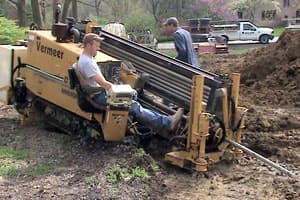Directional Loop Options
When is directional boring the right method?
- A utility line crosses perpendicular inside the proposed loop field.
- A homeowner is willing to spend extra money to minimize landscape damage.
- Water wells within the proximity prevent vertical drilling due to setback requirements.
- A homeowner wants a horizontal loop in a pasture or play area where tripping is a concern.
- A fence must be crossed that is not easily removed and replaced.
- Ground proposed for loop field is in CRP, CREP, or a similar program.
- A shed, barn, or outbuilding with no basement prevents using other horizontal methods.
- The landscape is too hilly for a trencher to operate safely.

A few things to consider about directional boring:
- Like all drilling methods, water in abundance is required on site.
- The exiting end of the field is usually far away from electricity, so a generator must be carried within range of 1 extension cord for a fusion tool (Power lost over cord distances will quickly burn up expensive fusion tools). No shots into brushy woods, please.
- Buried concrete or metal can cause the bore head or pipe to become stuck in the ground. It is not wise to bore through buried trash or old building sites. If a bore head becomes stuck, we will dig it up and recover it.
- The ultrasonic locaters do not operate well around high voltage lines. Interference can cause poor readings.
- A directional loop field will be more in the shape of a fan, or a peacock's tail than a box. We start at one edge and turn like the hand of a clock.
